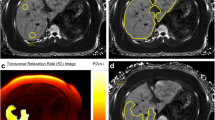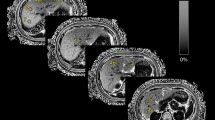Abstract
Purpose
To compare agreement between region-of-interest (ROI)- and parametric map-based methods of hepatic proton density fat fraction (PDFF) estimation in adults with known or suspected hepatic steatosis secondary to chronic liver disease over a range of imaging and analysis conditions.
Materials and methods
In this IRB approved HIPAA compliant prospective single-site study, 31 adults with chronic liver disease undergoing clinical gadoxetic acid-enhanced liver magnetic resonance imaging at 3 T were recruited. Multi-echo gradient-echo imaging at flip angles of 10° and 50° was performed before and after administration of gadoxetic acid. Six echoes were acquired at successive nominally out-of-phase and in-phase echo times. PDFF was estimated with a nonlinear fitting algorithm using the first two, three, four, five, and (all) six echoes. Hence, 20 different imaging and analysis conditions were used (pre/post contrast x low/high flip angle x 2/3/4/5/6 echoes). For each condition, PDFF estimation was done in corresponding liver locations using two methods: a region-of-interest (ROI)-based method in which mean signal intensity values within ROIs were run through the fitting algorithm, and a parametric map-based method in which individual signal intensities were run through the fitting algorithm pixel by pixel. Agreement between ROI- and map-based PDFF estimation was assessed by Bland–Altman and intraclass correlation (ICC) analysis.
Results
Depending on the condition and method, PDFF ranged from −2.52% to 45.57%. Over all conditions, mean differences between ROI- and map-based PDFF estimates ranged from 0.04% to 0.24%, with all ICCs ≥0.999.
Conclusion
Agreement between ROI- and parametric map-based PDFF estimation is excellent over a wide range of imaging and analysis conditions.





Similar content being viewed by others
References
Reeder SB, Cruite I, Hamilton G, Sirlin CB (2011) Quantitative assessment of liver fat with magnetic resonance imaging and spectroscopy. J Magn Reson Imaging 34(4):729–749
Tang A, Tan J, Sun M, et al. (2013) Nonalcoholic fatty liver disease: MR imaging of liver proton density fat fraction to assess hepatic steatosis. Radiology 267(2):422–431
Tang A, Desai A, Hamilton G, et al. (2015) Accuracy of MR imaging-estimated proton density fat fraction for classification of dichotomized histologic steatosis grades in nonalcoholic fatty liver disease. Radiology 274(2):416–425
Yokoo T, Bydder M, Hamilton G, et al. (2009) Nonalcoholic fatty liver disease: diagnostic and fat-grading accuracy of low-flip-angle multiecho gradient-recalled-echo MR imaging at 1.5 T. Radiology 251(1):67–76
Yokoo T, Shiehmorteza M, Hamilton G, et al. (2011) Estimation of hepatic proton-density fat fraction by using MR imaging at 3.0 T. Radiology 258(3):749–759
Negrete LM, Middleton MS, Clark L, et al. (2014) Inter-examination precision of magnitude-based MRI for estimation of segmental hepatic proton density fat fraction in obese subjects. J Magn Reson Imaging 39(5):1265–1271
Kang GH, Cruite I, Shiehmorteza M, et al. (2011) Reproducibility of MRI-determined proton density fat fraction across two different MR scanner platforms. J Magn Reson Imaging 34(4):928–934
Mashhood A, Railkar R, Yokoo T, et al. (2013) Reproducibility of hepatic fat fraction measurement by magnetic resonance imaging. J Magn Reson Imaging 37(6):1359–1370
Artz NS, Haufe WM, Hooker CA, et al. (2015) Reproducibility of MR-based liver fat quantification across field strength: same-day comparison between 1.5 T and 3 T in obese subjects. J Magn Reson Imaging 42(3):811–817
Loomba R, Sirlin CB, Ang B, et al. (2015) Ezetimibe for the treatment of nonalcoholic steatohepatitis: assessment by novel MRI and MRE in a randomized trial (MOZART Trial). Hepatology 61(4):1239–1250
Hamilton G, Yokoo T, Bydder M, et al. (2011) In vivo characterization of the liver fat (1)H MR spectrum. NMR Biomed 24(7):784–790
Yu H, Shimakawa A, McKenzie CA, et al. (2008) Multiecho water-fat separation and simultaneous R2* estimation with multifrequency fat spectrum modeling. Magn Reson Med 60(5):1122–1134
Arras KO (1998) An introduction to error propagation: derivation, meaning and examples of Cy = Fx Cx Fx′.
Levin YS, Yokoo T, Wolfson T, et al. (2014) Effect of echo-sampling strategy on the accuracy of out-of-phase and in-phase multiecho gradient-echo MRI hepatic fat fraction estimation. J Magn Reson Imaging 39(3):567–575
Bonekamp S, Tang A, Mashhood A, et al. (2014) Spatial distribution of MRI-determined hepatic proton density fat fraction in adults with nonalcoholic fatty liver disease. J Magn Reson Imaging 39(6):1525–1532
Yokoo T, Collins JM, Hanna RF, et al. (2008) Effects of intravenous gadolinium administration and flip angle on the assessment of liver fat signal fraction with opposed-phase and in-phase imaging. J Magn Reson Imaging 28(1):246–251
Bydder M, Yokoo T, Hamilton G, et al. (2008) Relaxation effects in the quantification of fat using gradient echo imaging. Magn Reson Imaging 26(3):347–359
Liu CY, McKenzie CA, Yu H, Brittain JH, Reeder SB (2007) Fat quantification with IDEAL gradient echo imaging: correction of bias from T(1) and noise. Magn Reson Med 58(2):354–364
Henkelman RM (1985) Measurement of signal intensities in the presence of noise in MR images. Med Phys 12(2):232–233
Reeder SB, Hu HH, Sirlin CB (2012) Proton density fat-fraction: a standardized MR-based biomarker of tissue fat concentration. J Magn Reson Imaging 36(5):1011–1014
Acknowledgments
Yesenia Covarrubias.
Grant Support
The project described was partially supported by the National Institute of Diabetes and Digestive and Kidney Diseases, Grant No. R01DK088925 and National Institutes of Health, Grant No. TL1TR00098. The content is solely the responsibility of the authors and does not necessarily represent the official views of the NIH.
Author information
Authors and Affiliations
Corresponding author
Ethics declarations
Funding
This study was partially supported by the National Institutes of Health, Grants R01DK088925, and TL1TR00098.
Conflict of interest
Paul M. Manning, Gavin Hamilton, Kang Wang, Chulhyun Park, Jonathan C. Hooker, Tanya Wolfson, Anthony Gamst, William M. Haufe, Alex N. Schlein, and Michael S. Middleton declare that they have no conflict of interest. Claude B. Sirlin is a consultant to Bayer Healthcare and a member of an advisory board for Bayer Healthcare. He has also received research grants from Siemens and GE.
Ethical approval
All procedures performed in studies involving human participants were in accordance with the ethical standards of the institutional and/or national research committee and with the 1964 Helsinki declaration and its later amendments or comparable ethical standards.
Informed consent
Informed consent was obtained from all individual participants included in the study.
Rights and permissions
About this article
Cite this article
Manning, P.M., Hamilton, G., Wang, K. et al. Agreement between region-of-interest- and parametric map-based hepatic proton density fat fraction estimation in adults with chronic liver disease. Abdom Radiol 42, 833–841 (2017). https://doi.org/10.1007/s00261-016-0925-2
Published:
Issue Date:
DOI: https://doi.org/10.1007/s00261-016-0925-2




